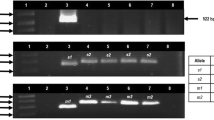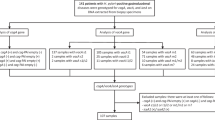Abstract
H. pylori infection of the stomach is widespread among human populations including Iranians and is considered to play a major role in the pathogenesis of gastric diseases such as peptic ulcer, adenocarcinoma, and MALT lymphoma. The association between H. pylorivirulence markers and disease has been studied in other populations around the world. The aim of this study was to investigate the distribution of H. pylori vacA and cagA genotypes and their association with clinical outcomes in Iran. H. pylori was cultured from gastric biopsy specimens obtained from 137 Iranian patients (58 with duodenal ulcer, 61 with nonulcer dyspeptic [NUD], and 18 with gastric adenocarcinoma). The vacA alleles and cagA genotypes were determined by PCR. The vacA sl allele was present in 107 of the 137 subjects (78%). Multiple strains (m1 and m2) were detected in H. pylori isolates from the patients. VacA s1 genotypes were more frequent in patients with peptic ulcer (46/58; 79%) than in NUD patients (47/61; 77%). CagA was present in 44% of the patients. NUD patients had a frequency of cagA positivity similar to that of the overall population (46%). CagA was present more frequently more than cagA-negative (20% vs. 8%, respectively) in patients with gastric carcinoma (20%) than cagA-negative in patients with gastric carcinoma (8%). This is the first comprehensive study to demonstrate the frequency of colonization with mixed strain, vacA s1, m1 and m2 as the dominant genotype in these Iranian patients, where a high rate of H. pylori infection exists and is similar to the region with a low rate of H. pylori infection. Therefore, host genetics, environmental factors, and the substantial genetic heterogeneity among different H. pylori strains may contribute to the different clinical outcomes.
Similar content being viewed by others
References
Dunn BE, Cohen H, Blaser MJ: Helicobacter pylori. Clin Microbiol Rev 10:720–741, 1997
Forsyth MH, Atherton JC, Blaser MJ, Cover TL: Heterogeneity in levels of vacuolating cytotoxin gene (vacA) transcription among Helicobacter pylori strains. Infect Immun 66:3088–3094, 1998
Mitchell HM, Hazell SL, Li YY, Hu PJ: Serological response to specific Helicobacter pylori antigens: antibody against CagA antigen is not predictive of gastric cancer in a developing country. Am J Gastroenterol 91:1785–1788, 1996
Go MF: Review article: natural history and epidemiology of Helicobacter pylori infection. Aliment Pharmacol Ther 16 (Suppl 1):3–15, 2002
Segal ED, Cha J, Lo J, Falkow S, Tompkins LS: Altered states: involvement of phosphorylated CagA in the induction of host cellular growth changes by Helicobacter pylori. Proc Natl Acad Sci USA 96:14559–14564, 1999
Censini S, Lange C, Xiang Z, Crabtree JE, Ghiara P, Borodovsky M, Rappuoli R, Covacci A: cag, a pathogenicity island of Helicobacter pylori, encodes type I-specific and disease-associated virulence factors. Proc Natl Acad Sci USA 93:14648–14653, 1996
Blaser MJ, Perez-Perez GI, Kleanthous H, Cover TL, Peek RM, Chyou PH, Stemmermann GN, Nomura A: Infection with Helicobacter pylori strains possessing cagA is associated with an increased risk of developing adenocarcinoma of the stomach. Cancer Res 55:2111–2115, 1995
Atherton JC, Cao P, Peek RM, Jr., Tummuru MK, Blaser MJ, Cover TL: Mosaicism in vacuolating cytotoxin alleles of Helicobacter pylori. Association of specific vacA types with cytotoxin production and peptic ulceration. J Biol Chem 270:17771–17777, 1995
van Doorn LJ, Figueiredo C, Sanna R, Pena S, Midolo P, Ng EK, Atherton JC, Blaser MJ, Quint WG: Expanding allelic diversity of Helicobacter pylori vacA. J Clin Microbiol 36:2597–2603, 1998
Pan ZJ, Berg DE, van der Hulst RW, Su WW, Raudonikiene A, Xiao SD, Dankert J, Tytgat GN, van der Ende A: Prevalence of vacuolating cytotoxin production and distribution of distinct vacA alleles in Helicobacter pylori from China. J Infect Dis 178:220–226, 1998
Atherton JC, Peek RM, Jr., Tham KT, Cover TL, Blaser MJ: Clinical and pathological importance of heterogeneity in vacA, the vacuolating cytotoxin gene of Helicobacter pylori. Gastroenterology 112:92–99, 1997
Malekzadeh R, Merat S, Derakhshan MH, Siavoshi F, Yazdanbod A, Mikaeli J, Sotoudemanesh R, Sotoudeh M, Farahvash MJ, Nasseri–Moghaddam S, Pourshams A, Dolatshahi S, Abedi B, Babaei M, Arshi S, Majidpour A: Low Helicobacter pylori eradication rates with 4- and 7-day regimens in an Iranian population. J Gastroenterol Hepatol 18:13–17, 2003
Massarrat S, Saberi-Firoozi M, Soleimani A, Himmelmann GW, Hitzges M, Keshavarz H: Peptic ulcer disease, irritable bowel syndrome and constipation in two populations in Iran. Eur J Gastroenterol Hepatol 7:427–433, 1995
Miehlke S, Kirsch C, Agha-Amiri K, Gunther T, Lehn N, Malfertheiner P, Stolte M, Ehninger G, Bayerdorffer E: The Helicobacter pylori vacA s1, m1 genotype and cagA is associated with gastric carcinoma in Germany. Int J Cancer 87:322–327, 2000
Kersulyte D, Chalkauskas H, Berg DE: Emergence of recombinant strains of Helicobacter pylori during human infection. Mol Microbiol 31:31–43, 1999
Gonzalez-Valencia G, Atherton JC, Munoz O, Dehesa M, la Garza AM, Torres J: Helicobacter pylori vacA and cagA genotypes in Mexican adults and children. J Infect Dis 182:1450–1454, 2000
Yamaoka Y, Kodama T, Gutierrez O, Kim JG, Kashima K, Graham DY: Relationship between Helicobacter pylori iceA, cagA, and vacA status and clinical outcome: studies in four different countries. J Clin Microbiol 37:2274–2279, 1999
Pan ZJ, van der Hulst RW, Feller M, Xiao SD, Tytgat GN, Dankert J, van der Ende A: Equally high prevalences of infection with cagA-positive Helicobacter pylori in Chinese patients with peptic ulcer disease and those with chronic gastritis-associated dyspepsia. J Clin Microbiol 35:1344–1347, 1997
Hou P, Tu ZX, Xu GM, Gong YF, Ji XH, Li ZS: Helicobacter pylori vacA genotypes and cagA status and their relationship to associated diseases. World J Gastroenterol 6:605–607, 2000
Ito Y, Azuma T, Ito S, Miyaji H, Hirai M, Yamazaki Y, Sato F, Kato T, Kohli Y, Kuriyama M: Analysis and typing of the vacA gene from cagA-positive strains of Helicobacter pylori isolated in Japan. J Clin Microbiol 35:1710–1714, 1997
Chun HJ, Park DK, Park CH, Park JH, Jeen YT, Um SH, Lee SW, Choi JH, Kim CD, Ryu HS, Hyun JH, Chae YS, Uhm CS: Electron microscopic evaluation of adhesion of Helicobacter pylori to the gastric epithelial cells in chronic gastritis. Korean J Intern Med 17:45–50, 2002
Go MF, Cissell L, Graham DY: Failure to confirm association of vac A gene mosaicism with duodenal ulcer disease. Scand J Gastroenterol 33:132–136, 1998
Evans DG, Queiroz DM, Mendes EN, Evans DJ Jr: Helicobacter pylori cagA status and s and m alleles of vacA in isolates from individuals with a variety of H. pylori–associated gastric diseases. J Clin Microbiol 36:3435–3437, 1998
van Doorn LJ: Detection of Helicobacter pylori virulence-associated genes. Expert Rev Mol Diagn 1:290–298, 2001
El-Mahdi AM, Patchett SE, Char S, Domizio P, Fedail SS, Kumar PJ: Does CagA contribute to ulcer pathogenesis in a developing country, such as Sudan? Eur J Gastroenterol Hepatol 10:313–316, 1998
Wong BC, Yin Y, Berg DE, Xia HH, Zhang JZ, Wang WH, Wong WM, Huang XR, Tang VS, Lam SK: Distribution of distinct vacA, cagA and iceA alleles in Helicobacter pylori in Hong Kong. Helicobacter 6:317–324, 2001
Bravo LE, van Doom LJ, Realpe JL, Correa P: Virulence-associated genotypes of Helicobacter pylori: Do they explain the African enigma? Am J Gastroenterol 97:2839–2842, 2002
Author information
Authors and Affiliations
Corresponding author
Rights and permissions
About this article
Cite this article
Siavoshi, F., Malekzadeh, R., Daneshmand, M. et al. Helicobacter pylori Endemic and Gastric Disease. Dig Dis Sci 50, 2075–2080 (2005). https://doi.org/10.1007/s10620-005-3010-1
Received:
Accepted:
Issue Date:
DOI: https://doi.org/10.1007/s10620-005-3010-1




